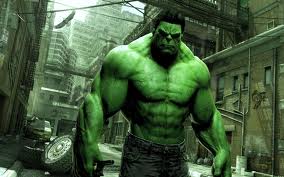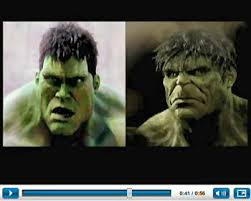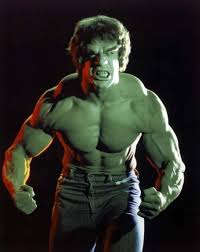Hulk (comics)
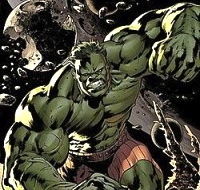
World War Hulk – The Mothion Comic – Part 1 (Fan-Made) (HD)
An epic story of anger unbound! Exiled by a group of Marvel “heroes” to the savage alien planet of Sakaar, the Hulk raged, bled, and conquered through the pages of last year’s “Planet Hulk” epic, rising from slave to gladiator to king. Now the Hulk returns to Earth to wreak his terrible vengeance on Iron Man, Reed Richards, Dr. Strange, Black Bolt – and anyone else who gets in the way! Stronger than ever, accompanied by his monstrous Warbound gladiator allies, and possessed by the fiercest and purest rage imaginable, the Hulk may just tear this stupid planet in half! First in a new series of fan-made motion comic videos, from the Marvel Comics series, featuring a fully dramatised vocal enactment by myself and completely enhanced with music and sound effects. All World War – The Motion Comic videos can be downloaded from this blogsite at: http://heroic-efforts.blogspot.com/.
 Promotional art for “The Incredible Hulk” vol. 2, #92 (April 2006) by Bryan Hitch.
Promotional art for “The Incredible Hulk” vol. 2, #92 (April 2006) by Bryan Hitch.
The Hulk is a fictional character, a comic book superhero appearing in publications by Marvel Comics. The character was created by Stan Lee and Jack Kirby, and first appeared in The Incredible Hulk #1 (May 1962). Throughout his comic book appearances, the Hulk is portrayed as a large green humanoid that possesses near limitless superhuman strength and great invulnerability, attributes that grow more potent the angrier he becomes. Hulk is the alter ego of Bruce Banner, a socially withdrawn and emotionally reserved physicist who physically transforms into the Hulk under emotional stress and other specific circumstances at will or against it; these involuntary transformations lead to many complications in Banner’s life. When transformed, the Hulk often acts as a disassociated separate personality that hates Banner. Over the decades of Hulk stories, the Hulk has been represented with several different personalities based on Hulk and Banner’s fractured psyche, ranging from mindless savage to brilliant warrior, and Banner has taken control of the Hulk’s form on occasion. Banner first transforms into the Hulk after being caught in the blast of the gamma bomb he invented while saving Rick Jones, a youth who had wandered onto the testing range.
Lee said that the Hulk’s creation was inspired by a combination of Frankenstein and Dr. Jekyll and Mr. Hyde. Although the Hulk’s coloration has varied throughout the character’s publication history, the most consistent shade is green. As a child, Banner’s father Brian Banner often got mad and physically abused his mother, creating the psychological complex of fear, anger, and the fear of anger and the destruction it can cause that underlies the character. A common storyline is the pursuit of both Banner and the Hulk by the U.S. armed forces, because of all the destruction that he causes. He has two main catchphrases: “Hulk is strongest one there is!” and the better-known “HULK SMASH!”, which has founded the basis for a number of pop culture memes.
The Hulk has been depicted in various other media, most notably with Bill Bixby (as Dr. David Banner, and Lou Ferrigno as the Hulk) in a live-action, 1970’s/1980’s television series. In major film adaptations (which integrate various CGI versions of the creature), Eric Bana, Edward Norton, and Mark Ruffalo have each played Bruce Banner. Other depictions include multiple animated series; the character has also been used in highly-profitable merchandising for generations (e.g., video games, toys, clothing). In 2011 Hulk placed 9th on IGN’s Top 100 Comic Book Heroes.
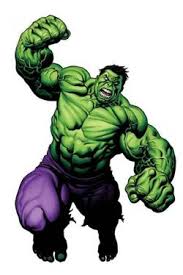 Publication history – Concept and creation
Publication history – Concept and creation
The Hulk first appeared in The Incredible Hulk #1 (cover dated May 1962), written by writer-editor Stan Lee, penciled and co-plotted by Jack Kirby, and inked by Paul Reinman. Lee cites influence from Frankenstein and Dr. Jekyll and Mr. Hyde in the Hulk’s creation:
“It was patently apparent that [the monstrous character the] Thing was the most popular character in [Marvel’s recently created superhero team the] Fantastic Four…. For a long time I’d been aware of the fact that people were more likely to favor someone who was less than perfect…. It’s a safe bet that you remember Quasimodo, but how easily can you name any of the heroic, handsomer, more glamorous characters in The Hunchback of Notre Dame? And then there’s Frankenstein… I’ve always had a soft spot in my heart for the Frankenstein monster. No one could ever convince me that he was the bad guy…. He never wanted to hurt anyone; he merely groped his torturous way through a second life trying to defend himself, trying to come to terms with those who sought to destroy him. … I decided I might as well borrow from Dr. Jekyll and Mr. Hyde as well — our protagonist would constantly change from his normal identity to his superhuman alter ego and back again.”
Lee also compared Hulk to the Golem of Jewish myth. In The Science of Superheroes, Gresh and Weinberg see the Hulk as a reaction to the Cold War and the threat of nuclear attack, an interpretation shared by Weinstein in Up, Up and Oy Vey. This interpretation corresponds well when taken into account alongside other popularized fictional media created during this time period, which took advantage of the prevailing sense among Americans that nuclear power could produce monsters and mutants. Arie Kaplan calls Hulk “schizophrenic.” Jack Kirby has also commented upon his influences in drawing the character, recalling as inspiration the tale of a mother who rescues her child who is trapped beneath a car.
In the debut, Lee chose gray for the Hulk because he wanted a color that did not suggest any particular ethnic group. Colorist Stan Goldberg, however, had problems with the gray coloring, resulting in different shades of gray, and even green, in the issue. After seeing the first published issue, Lee chose to change the skin color to green. Green was used in retellings of the origin, with even reprints of the original story being recolored for the next two decades, until The Incredible Hulk vol. 2, #302 (December 1984) reintroduced the gray Hulk in flashbacks set close to the origin story. Since then, reprints of the first issue have displayed the original gray coloring, with the fictional canon specifying that the Hulk’s skin had initially been gray. An exception is the early trade paperback, Origins of Marvel Comics, from 1974, which explains the difficulties in keeping the gray color consistent in a Stan Lee written prologue, and reprints the origin story keeping the gray coloration.
Publication
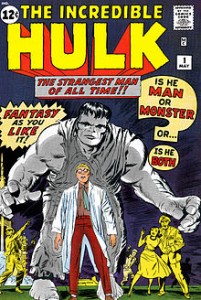 The Incredible Hulk #1 (May 1962). Cover art by Jack Kirby and Paul Reinman.
The Incredible Hulk #1 (May 1962). Cover art by Jack Kirby and Paul Reinman.
The Hulk’s original series was canceled with issue #6 (March 1963). Lee had written each story, with Kirby penciling the first five issues and Steve Ditko penciling and inking the sixth. The character immediately guest-starred in The Fantastic Four #12 (March 1963), and months later became a founding member of the superhero team the Avengers, appearing in the first two issues of the team’s eponymous series (Sept. and Nov. 1963), and returning as an antagonist in issue #3 and as an ally in #5 (Jan.–May 1964). He then guest-starred in Fantastic Four #25–26 (April–May 1964), which revealed Banner’s full name as Robert Bruce Banner, and The Amazing Spider-Man#14 (July 1964).
Around this time, co-creator Kirby received a letter from a college dormitory stating the Hulk had been chosen as its official mascot. Kirby and Lee realized their character had found an audience in college-age readers.
A year and a half after The Incredible Hulk was canceled, Hulk became one of two features in Tales to Astonish, beginning in issue #60 (Oct. 1964).
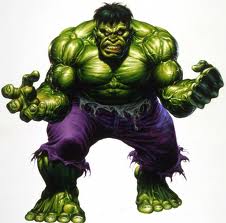 This new Hulk feature was initially scripted by Lee, with pencils by Steve Ditko and inks by George Roussos. Other artists later in this run included Jack Kirby (#68–87, June 1965 – Oct. 1966); Gil Kane (credited as “Scott Edwards”, #76, (Feb. 1966)); Bill Everett (#78–84, April–Oct. 1966); John Buscema (#85-87); and Marie Severin. TheTales to Astonish run introduced the super-villains the Leader, who would become the Hulk’s archnemesis, and the Abomination, another gamma-irradiated being. Marie Severin finished out the Hulk’s run in Tales to Astonish. Beginning with issue #102 (April 1968) the book was retitled The Incredible Hulk vol. 2, and ran until 1999, when Marvel canceled the series and launched Hulk #1.
This new Hulk feature was initially scripted by Lee, with pencils by Steve Ditko and inks by George Roussos. Other artists later in this run included Jack Kirby (#68–87, June 1965 – Oct. 1966); Gil Kane (credited as “Scott Edwards”, #76, (Feb. 1966)); Bill Everett (#78–84, April–Oct. 1966); John Buscema (#85-87); and Marie Severin. TheTales to Astonish run introduced the super-villains the Leader, who would become the Hulk’s archnemesis, and the Abomination, another gamma-irradiated being. Marie Severin finished out the Hulk’s run in Tales to Astonish. Beginning with issue #102 (April 1968) the book was retitled The Incredible Hulk vol. 2, and ran until 1999, when Marvel canceled the series and launched Hulk #1.
Len Wein wrote the series from 1974 through 1978, working first with Herb Trimpe, then, as of issue #194 (December 1975), with Sal Buscema, who was the regular artist for ten years. Issues #180–181 (Oct.–Nov. 1974) introduced the character Wolverine as an antagonist, who would go on to become one of Marvel Comics’ most popular. In 1977, Marvel launched a second title, The Rampaging Hulk, a black-and-white comics magazine. This was originally conceived as a flashback series, set between the end of his original, short-lived solo title and the beginning of his feature in Tales to Astonish. After nine issues, the magazine was retitled The Hulk! and printed in color.
Bill Mantlo became the series’ writer for five years beginning with issue #245 (March 1980). Mantlo’s “Crossroads of Eternity” stories (#300–313, Oct. 1984 – Nov.1985) explored the idea that Banner had suffered child abuse. Greg Pak, a writer on The Incredible Hulk vol. 2, called these stories an influence on his approach to the character. Mantlo left the series for Alpha Flightand that series’ writer John Byrne took over The Incredible Hulk. The final issue of Byrne’s six issue run featured the wedding of Bruce Banner and Betty Ross. Writer Peter David began a twelve-year run with issue #331 (May 1987). He returned to theRoger Stern and Mantlo abuse storylines, expanding the damage caused, and depicting Banner as suffering dissociative identity disorder (DID).
In 1998, David killed off Banner’s long-time love Betty Ross. Marvel executives used Ross’ death as an opportunity to pursue the return of the Savage Hulk. David disagreed, leading to his parting ways with Marvel. Also in 1998, Marvel relaunched The Rampaging Hulk as a standard comic book rather than as a comics magazine. The Incredible Hulk was again cancelled with issue #474 of its second volume in March 1999 and was replaced with new series, Hulk the following month, with returning writer Byrne and art by Ron Garney. By issue #12 (March 2000), Hulk was retitled as The Incredible Hulk vol. 3 New series writer Paul Jenkins developed the Hulk’s multiple personalities, and his run was followed by Bruce Jones with his run featuring Banner being pursued by a secret conspiracy and aided by the mysterious Mr. Blue. Jones appended his 43-issueIncredible Hulk run with the limited series Hulk/Thing: Hard Knocks #1–4 (Nov. 2004 – Feb. 2005), which Marvel published after putting the ongoing series on hiatus. Peter David, who had initially signed a contract for the six-issue Tempest Fugit limited series, returned as writer when it was decided to make that story the first five parts of the revived volume three. After a four-part tie-in to the House of M crossover and a one-issue epilogue, David left the series once more, citing the need to do non-Hulk work for the sake of his career.
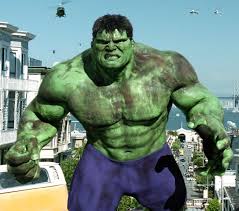 Writer Greg Pak took over the series in 2006, leading the Hulk through several crossover storylines including “Planet Hulk” and “World War Hulk“, which left the Hulk temporarily incapacitated and replaced as the series’ title character by the demigod Hercules (Marvel Comics) in the retitled The Incredible Hercules (Feb. 2008). The Hulk returned periodically in Hulk, which then starred the new Red Hulk. In September 2009, The Incredible Hulk was relaunched as The Incredible Hulk vol. 2, #600. The series was retitled The Incredible Hulks with issue #612 (Nov. 2010) to encompass the Hulk’s expanded family, and ran until issue #635 (Oct. 2011) when it was replaced with The Incredible Hulk vol. 4, (15 issues, Dec. 2011 – Dec. 2012) written by Jason Aaron with art by Marc Silvestri. As part of Marvel’s Marvel NOW! relaunch, the Hulk’s new title was The Indestructible Hulk (Nov. 2012) under the creative team of Mark Waid and Leinil Yu.
Writer Greg Pak took over the series in 2006, leading the Hulk through several crossover storylines including “Planet Hulk” and “World War Hulk“, which left the Hulk temporarily incapacitated and replaced as the series’ title character by the demigod Hercules (Marvel Comics) in the retitled The Incredible Hercules (Feb. 2008). The Hulk returned periodically in Hulk, which then starred the new Red Hulk. In September 2009, The Incredible Hulk was relaunched as The Incredible Hulk vol. 2, #600. The series was retitled The Incredible Hulks with issue #612 (Nov. 2010) to encompass the Hulk’s expanded family, and ran until issue #635 (Oct. 2011) when it was replaced with The Incredible Hulk vol. 4, (15 issues, Dec. 2011 – Dec. 2012) written by Jason Aaron with art by Marc Silvestri. As part of Marvel’s Marvel NOW! relaunch, the Hulk’s new title was The Indestructible Hulk (Nov. 2012) under the creative team of Mark Waid and Leinil Yu.
During the experimental detonation of a gamma bomb, scientist Bruce Banner rushes to save teenager Rick Jones who has driven onto the testing field; Banner pushes Jones into a trench to save him, but is himself hit with the blast, absorbing massive amounts of gamma radiation. He awakens later in an infirmary, seeming relatively unscathed, but that night transforms into a lumbering gray form that breaks through the wall and escapes. A soldier in the ensuing search party dubs the otherwise unidentified creature a “hulk.” The original incarnation of Banner transformed into the Hulk at sunset and reverted at sunrise. Banner was cured in The Incredible Hulk #4, but chose to restore Hulk’s powers with Banner’s intelligence. The gamma-ray machine needed to effect the transformation induced side-effects that made Banner temporarily sick and weak when returned to his normal state.
In Avengers #1 (September 1963), with no explanation of what he was doing since Hulk #6, Hulk became a founding member of the title’s eponymous superhero team. However, by The Avengers #3, overuse of the gamma ray machine rendered Hulk as an uncontrollable, rampaging monster, subject to spontaneous changing back & forth. In Tales to Astonish #59 (September 1964) Hulk appeared as an antagonist for Giant-Man. The series established stress as the trigger for Banner turning into Hulk and vice versa. It was during this time that the Hulk developed a more savage and childlike personality, shifting from the brutish figure who spoke in complete sentences and his memory, both long-term and short-term, was markedly impaired in his Hulk state. InTales to Astonish #77 (March 1966), Banner’s and the Hulk’s dual identity became publicly known when Glenn Talbot, Banner’s romantic rival for Betty, witnessed his transformation, turning Banner into a wanted fugitive.
The 1970s saw Banner and Betty nearly marry in The Incredible Hulk #124 (Feb. 1970). Betty ultimately married Talbot in issue #158 (Dec. 1972). Hulk also traveled to other dimensions, one of which had him meet empress Jarella, who used magic to bring Banner’s intelligence to Hulk, and came to love him. Hulk helped to form the Defenders.
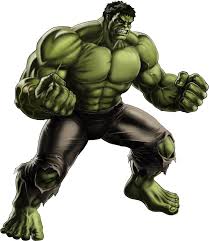 In the 1980’s, Banner finally married Betty in The Incredible Hulk #319 (May 1986) following Talbot’s death in 1981. It was also established that Banner had serious mental problems even before he became the Hulk, having suffered childhood traumas that engendered Bruce’s repressed rage. The gray Hulk persona “Joe Fixit” was introduced, a morally ambiguous Las Vegas enforcer and tough guy. Banner remained repressed in Hulk’s mind for months, but slowly begins to reappear. Banner comes to terms with his issues for a time, and Hulk and Banner were physically separated by Doc Samson. Banner is recruited by the U.S. government to create the Hulkbusters, a government team dedicated to catching Hulk. Banner and Hulk were reunited inThe Incredible Hulk #323 (Sep. 1986) and with issue #324, returned the Hulk to his gray coloration, with his transformations occurring at night, regardless of Banner’s emotional state.
In the 1980’s, Banner finally married Betty in The Incredible Hulk #319 (May 1986) following Talbot’s death in 1981. It was also established that Banner had serious mental problems even before he became the Hulk, having suffered childhood traumas that engendered Bruce’s repressed rage. The gray Hulk persona “Joe Fixit” was introduced, a morally ambiguous Las Vegas enforcer and tough guy. Banner remained repressed in Hulk’s mind for months, but slowly begins to reappear. Banner comes to terms with his issues for a time, and Hulk and Banner were physically separated by Doc Samson. Banner is recruited by the U.S. government to create the Hulkbusters, a government team dedicated to catching Hulk. Banner and Hulk were reunited inThe Incredible Hulk #323 (Sep. 1986) and with issue #324, returned the Hulk to his gray coloration, with his transformations occurring at night, regardless of Banner’s emotional state.
The 1990s saw the Green Hulk return. In issue #377 (Jan. 1991), the Hulk was revamped in a storyline that saw the personalities of Banner, Grey Hulk, and Savage Hulk confront Banner’s past abuse at the hands of his father Brian and a new “Guilt Hulk” persona. Overcoming the trauma, the intelligent Banner, cunning Grey Hulk, and powerful Savage Hulk personalities merge into a new single entity possessing the traits of all three. The Hulk also joined the Pantheon, a secretive organization of superpowered individuals. His tenure with the organization brought Hulk into conflict with a tyrannical alternate future version of himself called the Maestro in the 1993 Future Imperfect miniseries, who rules over a world where many heroes are dead.
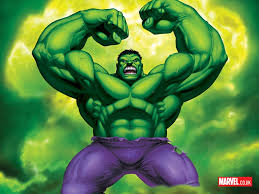 In 2000, Banner and the three Hulks (savage Hulk, gray Hulk, and the “merged Hulk”, now considered a separate personality and referred to as the Professor) become able to mentally interact with one another, each personality taking over the shared body. During this, the four personalities (including Banner) confronted yet another submerged personality, a sadistic “Devil” intent on attacking the world. In 2005, it is revealed that the supernatural character Nightmare has manipulated the Hulk for years, and it is implied that some or all of the Hulk’s adventures written by Bruce Jones may have been just illusion. In 2006, the Illuminati decide the Hulk is too dangerous to remain on Earth and send him away by rocket ship which crashes on Planet Sakaar ushering in the Planet Hulk storyline that saw Hulk find allies in the Warbound, and marry alien queen Caiera, a relationship that was later revealed to have bore him two sons: Skaar and Hiro-Kala. After the Illuminati’s ship explodes and kills Caiera, Hulk returns to Earth with his Warbound and declares war on the planet in World War Hulk (2007).
In 2000, Banner and the three Hulks (savage Hulk, gray Hulk, and the “merged Hulk”, now considered a separate personality and referred to as the Professor) become able to mentally interact with one another, each personality taking over the shared body. During this, the four personalities (including Banner) confronted yet another submerged personality, a sadistic “Devil” intent on attacking the world. In 2005, it is revealed that the supernatural character Nightmare has manipulated the Hulk for years, and it is implied that some or all of the Hulk’s adventures written by Bruce Jones may have been just illusion. In 2006, the Illuminati decide the Hulk is too dangerous to remain on Earth and send him away by rocket ship which crashes on Planet Sakaar ushering in the Planet Hulk storyline that saw Hulk find allies in the Warbound, and marry alien queen Caiera, a relationship that was later revealed to have bore him two sons: Skaar and Hiro-Kala. After the Illuminati’s ship explodes and kills Caiera, Hulk returns to Earth with his Warbound and declares war on the planet in World War Hulk (2007).
In the 2010s Hiro-Kala traveled to Earth to destroy the OldStrong Power wielded by Skaar, forcing Skaar and the Hulk to defeat and imprison him within his home planet. Hulk decides to allow Dr. Doom to split Banner and Hulk. Banner also willingly joined the spy organization S.H.I.E.L.D., allowing them to use Hulk as a weapon in exchange for providing him with the means and funding to create a lasting legacy for himself.
During his decades of publication, Banner has been portrayed differently, but common themes persist. Banner, a physicist is sarcastic and seemingly very self-assured when he first appears in Incredible Hulk #1, but is also emotionally withdrawn in most fashions. Banner designed the gamma bomb which caused his affliction, and the ironic twist of his self-inflicted fate has been one of the most persistent common themes. Arie Kaplan describes the character thus: “Bruce Banner lives in a constant state of panic, always wary that the monster inside him will erupt, and therefore he can’t form meaningful bonds with anyone.” As a child, Banner’s father Brian often got mad and physically abused Banner’s mother, creating the psychological complex of fear, anger, and the fear of anger and the destruction it can cause that underlies the character.
His fractured personality led to transformations into different versions of the Hulk. These transformations are usually involuntary, and often writers have tied the transformation to emotional triggers, such as rage and fear. Writers have adapted the Hulk, changing Hulk’s personality to reflect changes in Banner’s physiology or psyche. Banner has been shown to be emotionally repressed, but capable of deep love for Betty Ross, and for solving problems posed to him. Under the writing of Paul Jenkins, Banner was shown to be a capable fugitive, applying deductive reasoning and observation to figure out the events transpiring around him. On the occasions that Banner has controlled the Hulk’s body, he has applied principles of physics to problems and challenges and used deductive reasoning. It was shown after his ability to turn into the Hulk was taken away by the Red Hulk that Banner has been extremely versatile as well as cunning when dealing with the many situations that followed. When he was briefly separated from the Hulk by Doom, Banner became criminally insane, driven by his desire to regain the power of the Hulk, but once the two recombined he came to accept that he was a better person with the Hulk to provide something for him to focus on controlling rather than allowing his intellect to run without restraint against the world.
The original version of Hulk was often shown as simple and quick to anger. The Hulk generally divorces his identity from Banner’s, decrying Banner as “that puny weakling in the picture.” From his earliest stories, the Hulk has been concerned with finding sanctuary and quiet and often is shown reacting emotionally to situations quickly. Grest and Weinberg call Hulk the “dark, primordial side of [Banner’s] psyche.” Even in the earliest appearances, Hulk spoke in the third person. Hulk retains a modest intelligence, thinking and talking in full sentences, and Lee even gives the Hulk expository dialogue in issue six, allowing readers to learn just what capabilities Hulk has, when the Hulk says, “But these muscles ain’t just for show! All I gotta do is spring up and just keep goin’!”
In the 1970’s, Hulk was shown as more prone to anger and rage, and less talkative. Writers played with the nature of his transformations, briefly giving Banner control over the change, and the ability to maintain control of his Hulk form.
Artistically, the character has been depicted as progressively more muscular in the years since his debut.

